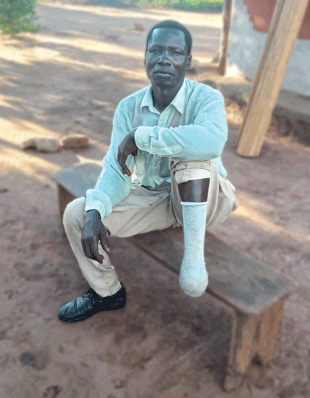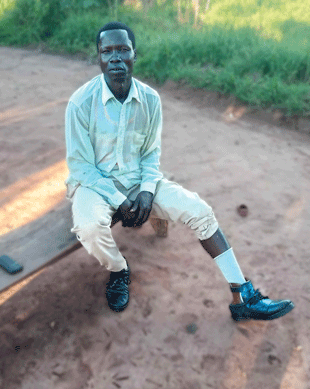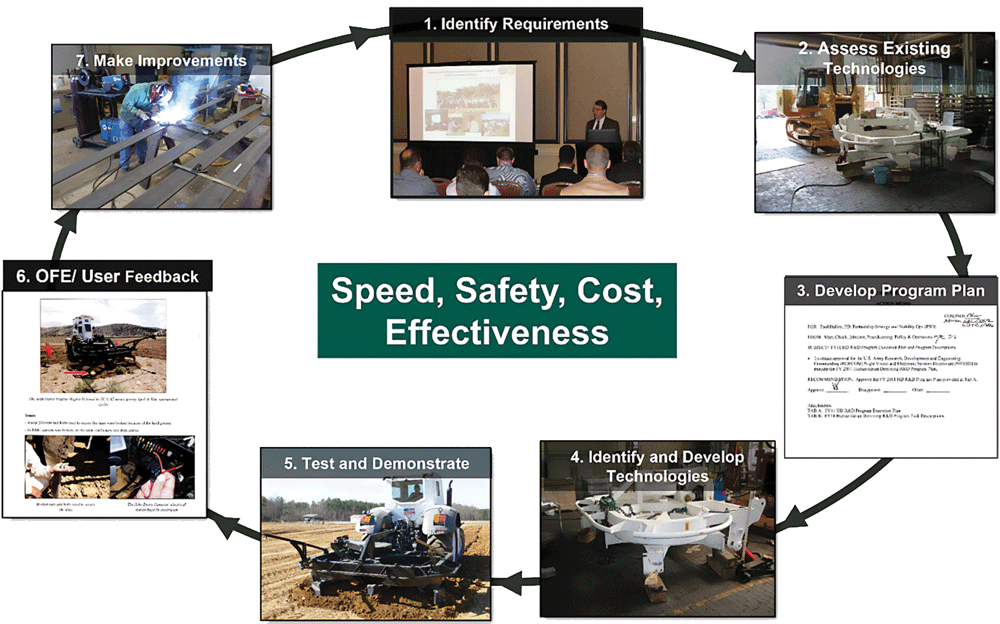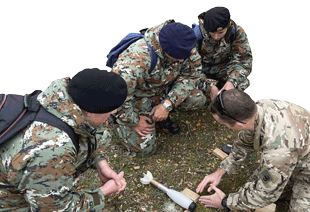United States Agency for International Development: Patrick J. Leahy War Victims Fund
Access to Rehabilitation Services Drives Independence
The United States Agency for International Development’s (USAID) Leahy War Victims Fund, established in 1989, provides U.S. assistance to civilian survivors of conflict in developing countries. The fund is a dedicated source of financial and technical support to develop sustainable, quality, physical rehabilitation services, including prosthetic and orthotic, physical and occupational therapy, and assistive technology services in conflict-affected countries. The fund supports the development of a range of services within health systems, while maintaining its vital focus on victims of conflict and persons with disabilities
In 2023, the Leahy War Victims Fund provided more than $13 million to support the rehabilitation of conflict survivors in 16 countries. To date, the fund has provided approximately $350 million in assistance to more than 50 countries.
Leahy War Victims Fund’s Learning, Acting, and Building for Rehabilitation in Health Systems (ReLAB-HS) is a five-year global activity that supports strengthening health systems that are responsive to the growing need to implement context-appropriate, innovative, comprehensive, and cost-effective interventions that reinforce rehabilitation and assistive technology. For example, in Northern and Eastern Uganda, ReLAB-HS collaborates with national and local policymakers, health leaders and managers, and communities to assist conflict victims, including those from the 20-year civil war between 1986 - 2006.
Mark: Survivor of the Conflict in Northern Uganda

Mark, 52, a farmer and father of seven from Tupadach village, was 17 years old in 1988 when he was abducted and forced to serve as a rebel soldier. In 2003, Mark’s group was ambushed. While fleeing, he stepped on a landmine. After running about a kilometer, he realized that half of his foot was missing, and he had lost a lot of blood. Mark’s initial injuries were treated, but the subsequent care provided in captivity was inadequate.
In 2005, Mark successfully escaped and returned home. He had difficulty walking, experienced burning at the amputation site, and developed recurring sores and swelling of the affected limb. All these symptoms made it difficult for Mark to accomplish his daily activities.
In 2020, a Village Health Team member referred him to Gulu Regional Referral Hospital, where the program established by ReLAB-HS provided an appropriate prosthetic foot, physical rehabilitation, and psychological interventions. He now farms, cares for his family, and walks longer distances, while continuing to benefit from rehabilitation services when needed.

Mark states, “Before I received this prosthesis, I experienced pain, couldn’t move when it rained, couldn’t walk far without experiencing swelling, and I couldn’t farm because of fear of injury. The community members used to stigmatize me and shun my opinions due to my condition. But after receiving this prosthesis, my life has positively changed. I can now walk without experiencing any swelling, pain, and I can dig and maintain my home. As you see, [it is] very hard for people to even know that I am using a prosthesis. [I am] no longer afraid of rain, [there is] no more stigma, and my opinions are respected.”
U.S. Department of Defense: Humanitarian Demining Research and Development Program
The Humanitarian Demining Research and Development Program (HD R&D) develops, demonstrates, and evaluates technologies that increase the efficiency and safety of humanitarian demining and unexploded ordnance clearance operations. The program supports the Department of Defense geographic combatant commands as they accomplish their humanitarian mine action mission in their areas of operation, particularly in Department of Defense priority countries. The Countermine Division of the U.S. Army Combat Capabilities Development Command’s Command, Control, Communications, Computers, Cyber, Intelligence, Surveillance and Reconnaissance (C5ISR) Center, Research and Technology Integration Directorate executes the research and development program.
Along with the humanitarian mine action offices within the Geographic Combatant Commands, the program also coordinates with the Department of State’s Office of Weapons Removal and Abatement, the Defense Security Cooperation Agency, and its Humanitarian Demining Training Center.
Program developments in five major categories are designed to meet the challenges that deminers face in all aspects of their work: area preparation, mine and unexploded ordnance detection, mechanical mine clearance, mine neutralization, and survey and support.
The HD R&D Program Development Process:
- Identify requirements: Bring representatives from mine-affected nations together to identify and update their most critical needs. Additionally, in-country site assessment team visits help determine the most appropriate equipment for the situation.
- Assess Existing Technologies: The program uses extensive market research, including individual research, trade shows, and industry visits, to identify commercial off the shelf equipment that can be modified to meet a demining technology gap.
- Structure program, develop plan: A program execution plan is developed based on analysis of the previous three steps.
- Identify and develop equipment: In addition to commercial-off-the-shelf technologies, the program may use mature technologies or leverage existing military countermine technologies for in-house design, fabrication, and integration capability.
- Technical testing: Extensive technical testing is conducted to ensure all design requirements are met prior to deployment for operational field evaluation.
- Operational field evaluation: Nongovernmental organizations, host nation mine action centers, and foreign militaries partner with HD R&D to conduct field evaluations in their own demining operations while providing safety and effectiveness feedback to the HD R&D. Field evaluations are one of the most important aspects of the program because they take place in actual minefields and contaminated areas.
- Improve, upgrade promising prototypes: Feedback from demining organizations during operational field evaluations result in technology improvements and upgrades by HD R&D technicians or commercial manufacturers. Importantly, feedback from field evaluations feeds decisions on future technology development.

U.S. Department of Defense: Humanitarian Demining Training Center

U.S. European Command provides explosive ordnance disposal training. Courtesy of EUCOM.
In direct support of the U.S. National Security and Defense Strategies, the Department of Defense conducts its humanitarian mine action program to assist allies and partner nations in explosive remnants of war identification and disposal and physical security and conventional munitions stockpile management so civilians can return to everyday life and use the land without risk of explosive hazards.
The Defense Security Cooperation Agency operates the Humanitarian Demining Training Center (HDTC), based at Fort Gregg-Adams, Virginia. Since 1996, HDTC has leveraged the Overseas Humanitarian, Disaster, and Civic Aid appropriation to advance United States’ defense and foreign policy interests by training and preparing U.S. Department of Defense personnel and international partners to build partner nation capacity in humanitarian mine action and physical security and stockpile management using “Train the Trainer” instructional methods.
HDTC provides capacity-building training and technical assistance to partner nations in alignment with geographic combatant command security cooperation objectives. These projects are coordinated with and complement the Department of State’s Office of Weapons Removal and Abatement conventional weapons destruction programs. Further, in partnership with other public organizations or private industry, HDTC provides a suite of tools and expertise to assist foreign military and civil servants tasked with conducting humanitarian mine action.
HDTC‘s Humanitarian Mine Action Basic Courses train U.S. military forces and U.S. government stakeholders to prepare and deliver instruction in landmine and battle area clearance tasks, explosive ordnance disposal Levels 1-3, physical security and stockpile conventional munitions assistance, underwater explosive remnants of war clearance, and casualty care. This training supports International Mine Action Standards, International Ammunition Technical Guidelines, and international best practices. Students learn small group instructor skills, coaching, and practical application of mine action techniques and procedures to conduct activities assisting and teaching partner nations.
In FY2023, HDTC’s vital global mission trained over 215 U.S. military personnel to conduct independent instruction in over 23 countries and conducted mine awareness training activities to more than 100 military and U.S. government personnel in preparation to deploy to mine-affected countries.
